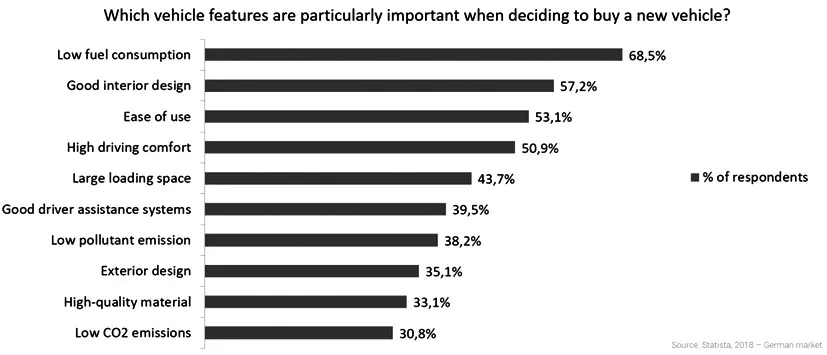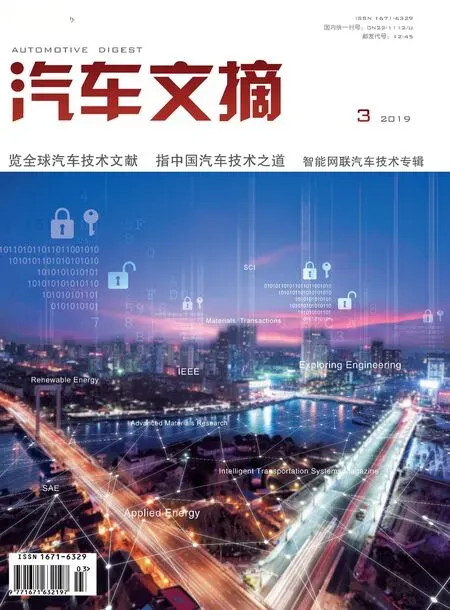現(xiàn)代汽車人機(jī)界面(HMI)設(shè)計(jì)趨勢(shì)
Dirk Beer,Sylvester Goettlicher,Julian Gauger
DAG Deutsche Automotive Software GmbH,70174 Stuttgart,Germany
主題詞:人機(jī)界面(HMI) 內(nèi)飾設(shè)計(jì) 易操作 信息娛樂(lè) 用戶界面(UI) 用戶體驗(yàn) 對(duì)標(biāo)
Introduction to the Current HMI Market Situation
Recent research shows that within the German market 86% of potential buyers regard usability as a core purchasing criterion[1].Offering a growing variety of functions might distract the driver from operating the vehicle safely which is why the aspect of safety has become asequally important as the aspect of usabilty.
So,by focusing on the following two criteria,the path for a good HMIshould be defined,right?
1.Provide the functionalities the customer has gotten used to through technological progress.
2.Ensure an intuitive user-flow to perform tasks in a safe way to minimize distraction.
In other words,a good car HMI can be seen as a balance between relevant functions and the ease of use.Nevertheless,there seems to be a big third trend that is threatening thisbalance massively:
The armsrace of HMI-functions.
Although car manufacturers are well aware that this trend not only significantly increases development costs without really increasing customer value,an iron rule seems to have established:if the competitor has the function,we need it,too.
What dramatic consequences this rule may have and how our HMI benchmarking platform "screens "helps OEMs not to fall into this trap,will be highlighted in this article.
The Arms Race of HMI-Functions
A couple of years ago customers were very much focused on the exterior aspects of a car rather than the interior comforts.Nowadays it is the other way round:The ease of use of a car’s HMI and helpful driver assistance systems are criteria the customers value a lot.Recent studies have shown that interior design(57,2%)and ease of use(53,1%)are way more relevant for buying decisions than exterior design(35,1%)[2].
Of course OEMs are aware of this development,however,they are in a controversial area of conflict since keeping up with the latest technologies,plus outperforming your competitor in terms of features,can mess up the ease of use and intuitivity in many ways.So why do OEMs stick to thiswhat we call?arms race of HMI-functions“?

Figure 1.Customer decision for new vehicle purchase[2]
By talking to more than one hundred interaction designers and developers from OEMs world wide,we found out there was one particular reason:The fear of missing out on a certain trend or not implementing a certain function is higher than not fulfilling the customer’s needs.How can this be?On the one hand,there are no studies available that show how and if customers actually use all of the features available in a vehicle.On the other hand,with several hundred cars beeing released worldwide every year,it is extremely hard to really know what the best HMI developments in the world are.The safest form of development therefore is:do what your competitor does and add an additional feature.
You may want to picture this task as preparing a meal for the entire family.Everyone has got a different taste and you want to satisfy all of them.Grandma and grandpa prefer a salty dish,the parent's something spicy and the kids want to have it sweet.One approach could be to put everything into the same pot.If the pot is a car’s HMI this approach leads to extremely overloaded displays bursting from functionalites.In terms of autonomous driving,the number of wishes and possibilities will increase even more.This intensification of the trend will lead to even more functionsfor the driver in the future.
Thus,to know which ingredients in form of functions are really relevant for the customer to create the perfect mixture,we regard two things as crucial:
1.Solid HMI-benchmarking to really know what's going on in the market
2.User field studies that show how HMIs are used in real life situations
Concerning the first point, we believe that benchmarking would help to give structure to the opaque market and allow HMI-developers to easily conduct important analyses.Because as our interviews have shown,OEMs are more afraid of not implementing a function rather than not meeting the needs of their customers.And the best way of facing this fear is reliable information.This is why we have spent the last two years developing an online HMI benchmarking database called “screens”which offers the possibility to deeply analyse the world’s top car HMI’s.A use case could evolve as follows:
Bob is an experienced HMI-developer who has been tasked by his management to develop the instrument cluster for a new electric vehicle.Now he has to transform dozens of functional requirements into intuitive icons and buttons and has countless ways of shaping the interaction concept.Of course,he wants to fuel his creativity through the latest electric car releases on the market.Normally,he would now indulge in a not very promising online search to find suitable video sequences and evaluations of current electric vehicles.What he really needs,though,is a place to find suitable answers to specific questions to underpin his development decisions.A place that provides him with profound evaluations and high-quality video material of relevant car HMIs.
Our benchmarking database“screens”offers for just that.It provides the latest and most relevant HMI-concepts in the world in extreme details and therefore it is about to establish evolve into one of the most important platforms in the development of car HMIs.It was specifically developed for designers and developers in the HMI environment and is tailored exactly to the needs of OEMs and suppliers.HMI developers could benefit a lot fromusing screens(Figure 2)[3].
Concerning the second point,the user field studies,we are aiming to conduct real-life situation studies to provide real customer feedback on which functions within the HMI actually matter and which are not necessary,from a customer point of view[3].

Figure 2.Example of viedo prodution for screens
Why does customer feedback collected from real-life situations matter?
In today's vehicles,there are hundreds of different functionalities implemented ranging from how to set up your instrument cluster,your favourites in media,radio,etc.However,the actual customer usually only needs a fraction of all those functionalities during the period of usage.The most consistent approach to this is made by Tesla.With very limited functionality,the HMIis still seen as advanced and competitive and therefore seems to fulfil most of the customer needs.
Outlook on HMI Development in the Automotive Sector
An interesting study conducted by McKinsey in regards to?Increasing importance in future competitors in the automotive industry“ is showing alarming,but somehow not surprising figures.The established brand's importance will only increase by 19% ,whereas Technology-and Software companies(46%),Start-ups(37%),new market participants from China/emerging markets(23%)are identified with gaining bigger shares in the industry[4].
Tech- and Software companies already set the standard through daily contact points in our life like smartphones,use of applications like Amazon,Uber and so on.And indeed,the automotive industry has been trying to keep up with this trend.Still,in regards to“the arms race of HMI-functions”the ease of use must become more important than a large number of functions,hence the motto is“disarming”.Figure 2 is HMI Example(ease of use),and Figure 3 is the HMIcurrent.

